San Pedro | |
|---|---|
| City of San Pedro | |
"Manok ni San Pedro" Welcome Monument San Pedro City Hall Pacita Astrodome Lolo Uweng Chapel Our Lady of Lourdes Parish Church Jose Rizal Monument Abelardo Remoquillo Monument | |
 Flag  Seal | |
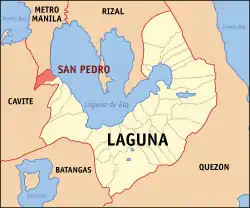 Map of Laguna with San Pedro highlighted | |
OpenStreetMap | |
.svg.png.webp) San Pedro Location within the Philippines | |
| Coordinates: 14°21′30″N 121°03′30″E / 14.3583°N 121.0583°E | |
| Country | Philippines |
| Region | Calabarzon |
| Province | Laguna |
| District | 1st district |
| Founded | January 18, 1725 |
| Annexation to Biñan | October 12, 1903 |
| Reestablished | January 7, 1907 |
| Renamed | February 28, 1914 (as San Pedro) |
| Cityhood | December 28, 2013[1][2] |
| Named for | Saint Peter |
| Barangays | 27 (see Barangays) |
| Government | |
| • Type | Sangguniang Panlungsod |
| • Mayor | Art Joseph Francis Mercado |
| • Vice Mayor | Divina D. Olivarez |
| • Representative | Ma. Rene Ann Lourdes G. Matibag |
| • City Council | Members[4]
|
| • Electorate | 174,499 voters (2022) |
| Area | |
| • Total | 24.05 km2 (9.29 sq mi) |
| • Rank | 29 out of 30 (in Laguna) |
| Elevation | 46 m (151 ft) |
| Highest elevation | 170 m (560 ft) |
| Lowest elevation | 2 m (7 ft) |
| Population (2020 census)[6] | |
| • Total | 326,001 |
| • Rank | 4 out of 30 (in Laguna)[7] |
| • Density | 14,000/km2 (35,000/sq mi) |
| • Households | 82,292 |
| Demonym(s) | Spanish: San Pedrense English: San Pedronian Filipino: San Pedronyan, Taga-San Pedro |
| Economy | |
| • Income class | 3rd city income class |
| • Poverty incidence | 1.99 |
| • HDI | |
| • Revenue | |
| • Assets | |
| • Expenditure | |
| • Liabilities | |
| Service provider Utilities | |
| • Electricity | Manila Electric Company (Meralco) |
| • Water |
|
| Time zone | UTC+8 (PST) |
| ZIP code | 4023 |
| PSGC | |
| IDD : area code | +63 (0)2 |
| Native languages | Tagalog |
| Website | cityofsanpedrolaguna |
San Pedro, officially the City of San Pedro (Filipino: Lungsod ng San Pedro), is a 3rd class [10]component city in the province of Laguna, Philippines. According to the 2020 census, it has a population of 326,001 people.[6]
It is named after its patron saint, Saint Peter.[11]
San Pedro has been dubbed as “dormitory town” of Metro Manila and migrants from other provinces commuting everyday through its highly efficient road and transport system. Despite being one of the smallest political units in the entire province, with a total land area of only 24.05 square kilometers (9.29 sq mi), San Pedro is the 5th most populous city (out of 6) after the cities of Calamba, Santa Rosa, Biñan and Cabuyao. The city also has the highest population density in the province of Laguna and in the whole Calabarzon region, having 14,000 inhabitants per square kilometer (36,000/sq mi).[11] As a first class municipality, it became a component city of Laguna by virtue of Republic Act No. 10420 dated March 27, 2013.[12]
Etymology
The name of San Pedro originates from its previous name: San Pedro Tunasán. The first part of the name comes from Spanish for its patron saint, Saint Peter;[11] while the second part comes from Tunasán, which literally means "a place where there is Tunás" (Nymphaea nouchali),[13] a medicinal plant abundant on the shoreline of Laguna de Bay.[11]
History
Early history

The Area of where the modern city of San Pedro is found served as the native settlement of the Tagalogs centuries before Spanish contact. Laguna de Bay and the San Isidro River gave livelihood and food to the early settlers. The Laguna Copperplate Inscription dated back to 900 AD mentioning the ancient polity of Tondo was found on Lumban, Laguna giving the idea that the area of San Pedro which some independent Ancient Barangays headed by their own Datus are settled was under the influence if not directly under the alliance network of the Lakan of Tondo.
On January 16, 1571, it was announced by Miguel López de Legazpi that a settlement called "Tabuko" which is an old Tagalog term that means "the end part of the river" be converted to an encomienda or a town under the helm of Gaspar Ramirez. A month after Miguel López de Legazpi established Manila as the capital of Spanish East Indies, Legazpi's grandson and conquistador Juan de Salcedo, while exploring the region of Laguna de Bay, founded a settlement in Biñan which was annexed as a barangay or village to Tabuko, a large town which also then comprised what are now the cities of San Pedro, Santa Rosa, and Cabuyao.
Spanish Period
San Pedro de Tunasán became a town on January 18, 1725, upon the request of San Pedrense Principalía led by Alonzo Magtibay, Francisco Santiago, and Ignacio de Guevarra and approved by the Governor-General and Manila Archbishop Francisco de la Cuesta, King Philip V of Spain decreed that the town formerly known as "Tabuko" be a separate town from "Kabuyaw" (present-day city of Cabuyao).[11][14] Francisco Santiago subsequently became the first mayor of the newly formed town.
By virtue of the last will of Philip V of Spain, Rodriguez de Figueroa or "Don Esteban", a group of Augustinian Fathers gained the ownership of the Tunasán Estate. Later on, San Pedro became an hacienda of Colegio de San José, a group of Jesuits who took over the property which now is known as "San Pedro Tunasán".
During that period, agriculture, fishing, duck raising, fruit trees, and sampaguita were the main source of income of its residents. This period was highlighted by the growing tenant/landlord dispute. The tenants of Hacienda San Pedro Tunasán fought for their birthrights over their ancestral lands. This struggle took almost 423 years of unsuccessful resistance to Colegio de San José, and in 1938, the government bought the home sites of the San Pedro Tunasán Hacienda from the Colegio for re-sale to its tenants. This event laid to rest the tenants/landlord problem in the town.
During the Philippine Revolution, after the execution of Andres and Procopio Bonifacio at Maragondon, Cavite on 1897, the group of Gregoria de Jesus, the widow of Andres, departed to San Pedro Tunasán to hide. They were welcomed by San Pedro native Gregoria Olivares and settled on the house of Almario Ilmedo on barrio San Roque.[15]
American Period
On October 12, 1903, San Pedro Tunasan was annexed to the adjacent municipality of Biñan by virtue of Act No. 939.[16] It was reconstituted as an independent municipality by virtue of Act No. 1308 dated October 29, 1906, thus separating it from Biñan effective January 7, 1907.[17] A barrio called Tunasancillo became part of the Municipio of Muntinlupa which was a part of the province of Manila when the town of San Pedro Tunasán sold it in 1907 during the American period.[18] On February 28, 1914, the name of the town, San Pedro de Tunasán, was shortened to its present name of San Pedro, by virtue of Act No. 2390.[19] From the Spanish time until after the Japanese occupation of the Philippines, the scenario did change a bit.
During World War II, Abelardo Remoquillo (1922-1945), known among his peers, war enemies, and admirers as “Captain Remo”, was a young guerrillero from San Pedro, Laguna who fought against the Japanese Imperial Army. He joined the Hunters ROTC guerilla and fought against the invaders from different fronts of Southern Luzón He also participated in the famous Raid at Los Baños. He died not in San Pedro but in faraway Bay, Laguna while attacking a Japanese garrison. He is now known as a local hero and has a monument on the historic town plaza of San Pedro.[20]
Contemporary History
On August 30, 1954, President Ramón Magsaysay signed at the historic town plaza the Land Tenancy Act. By virtue of this law, farm lots of the hacienda were bought by the Philippine government to be sold at cost to the tenants or occupants of the farm lots in Bayan-Bayanan under the Narra Settlement Project of the Magsaysay Administration. San Pedro became a resettlement area for families in Metro Manila in 1968 to 1971. Thereon population significantly increased with the rise of several GSIS/SSS housing projects in 1975. Industries sprouted in the succeeding years such as the Aclem Paper Mills, Holiday Hills Golf and Country Club (now KC Filipinas Golf Resort Club), Philippine Tobacco Flu Curing Corporation, Berbacs Chemicals, US Tobacco Corporation, Holland Milk Products, Trinity Lodge Mining Corporation, Kimberly Clark, Cosmos, among others.
The succeeding administration of ex Mayors Felicisimo Vierneza and Calixto Cataquiz brought significant changes in the political, economic and cultural landscape of San Pedro. There were major commercial and industrial developments during the administration of Mayor Vierneza starting 1972 while Mayor Cataquiz's 12- year administration in 1986 focused on residential subdivisions with massive infrastructure projects and beautification programs.[12]
Cityhood
On March 27, 2013, President Benigno Aquino III signed the Republic Act No. 10420[21] converting the municipality into a new component city of the province of Laguna. The cityhood of San Pedro was ratified through a plebiscite scheduled by the Commission on Elections (COMELEC). The date for the ratification is December 28, 2013, after the National Barangay Elections. It became the sixth city of Laguna after the cities of Biñan, Cabuyao, Calamba, San Pablo, and Santa Rosa, and also the third to be a city in the 1st congressional District Laguna - making it the first city district in the province.
COMELEC officially proclaimed the first-class municipality of San Pedro as a component city of Laguna on December 29, 2013. Juanito Icarro, regional director of Calabarzon and Mimaropa, and Marianne Marfori, provincial election supervisor, made the proclamation at the municipal hall after San Pedro residents voted for the cityhood in a plebiscite held on December 28, 2013. "Yes" votes for cityhood totaled 16,996 (which is an additional 50 votes added in some precincts mostly in the San Vicente area to win the "yes" vote), and "no" votes, only 869, in 501 clustered precincts in San Pedro. Only 11% of 165,777 registered voters in San Pedro's 27 barangays took part in the plebiscite.
Proposals
San Pedro as 18th member of Metro Manila
Support groups from the local government and non-government organizations are striving to incorporate San Pedro into Metro Manila.[22][23]
Former Metro Manila Development Authority (MMDA) Chairman Francis Tolentino is pushing for the inclusion of the city in the National Capital Region, and eventually become its 18th member city. Tolentino said that in the first meeting of the MMDA Council of mayors in January 2015, he would push for the inclusion of the city to the MMDA.[23]
San Pedro as a lone district in Laguna
Senator Aquilino "Koko" Pimentel III is seeking the separation of the city of San Pedro from the first legislative district of Laguna province to constitute a lone congressional district. In 2015, Pimentel filed Senate Bill No. 3029 for the creation of the San Pedro as a separate district to commence in the next national and local elections.[24]
After the city of Santa Rosa formally gained its own representation effective 2022, San Pedro remained as the only local government unit in the first district. Hence, the 1st District may be also referred as the Lone District of San Pedro.
Geography
San Pedro is located in Region IV-A or Calabarzon. San Pedro is the boundary between Laguna and Metro Manila, so San Pedro is known as "Laguna's Gateway to Metro Manila". San Pedro shares boundaries with Metro Manila's southernmost city, Muntinlupa (North) bounded with Tunasan River, Biñan (South), Dasmariñas (West), Carmona and Gen. Mariano Alvarez (Southwest) bound with San Isidro River. Its position makes San Pedro a popular suburban residential community, where many residents commute daily to Metro Manila for work.[11]
San Pedro is 58 kilometres (36 mi) from Santa Cruz and 29 kilometres (18 mi) from Manila.
Barangays

San Pedro is politically subdivided into 27 barangays. Barangay San Antonio is the largest barangay, which has a total of 780 hectares, while Barangay San Vicente is the most populous with a total population of 92,092.[25]
- Bagong Silang
- Calendola
- Chrysanthemum[lower-alpha 1]
- Cuyab
- Estrella
- Fatima[lower-alpha 1]
- G.S.I.S.
- Landayan
- Langgam
- Laram
- Maharlika[lower-alpha 1]
- Magsaysay
- Narra
- Nueva
- Pacita 1[lower-alpha 1]
- Pacita 2[lower-alpha 1]
- Poblacion
- Riverside
- Rosario[lower-alpha 1]
- Sampaguita Village
- San Antonio
- San Roque
- San Vicente
- San Lorenzo Ruiz[lower-alpha 1]
- Santo Niño
- United Bayanihan
- United Better Living
- Notes
Climate
| Climate data for San Pedro City, Laguna | |||||||||||||
|---|---|---|---|---|---|---|---|---|---|---|---|---|---|
| Month | Jan | Feb | Mar | Apr | May | Jun | Jul | Aug | Sep | Oct | Nov | Dec | Year |
| Mean daily maximum °C (°F) | 29 (84) |
30 (86) |
32 (90) |
34 (93) |
32 (90) |
31 (88) |
29 (84) |
29 (84) |
29 (84) |
30 (86) |
30 (86) |
29 (84) |
30 (87) |
| Mean daily minimum °C (°F) | 21 (70) |
20 (68) |
21 (70) |
22 (72) |
24 (75) |
24 (75) |
24 (75) |
24 (75) |
24 (75) |
23 (73) |
22 (72) |
21 (70) |
23 (73) |
| Average precipitation mm (inches) | 10 (0.4) |
10 (0.4) |
12 (0.5) |
27 (1.1) |
94 (3.7) |
153 (6.0) |
206 (8.1) |
190 (7.5) |
179 (7.0) |
120 (4.7) |
54 (2.1) |
39 (1.5) |
1,094 (43) |
| Average rainy days | 5.2 | 4.5 | 6.4 | 9.2 | 19.7 | 24.3 | 26.9 | 25.7 | 24.4 | 21.0 | 12.9 | 9.1 | 189.3 |
| Source: Meteoblue[27] | |||||||||||||
Demographics
| Year | Pop. | ±% p.a. |
|---|---|---|
| 1903 | 3,678 | — |
| 1918 | 4,184 | +0.86% |
| 1939 | 6,300 | +1.97% |
| 1948 | 9,063 | +4.12% |
| 1960 | 14,082 | +3.74% |
| 1970 | 32,991 | +8.88% |
| 1975 | 43,439 | +5.67% |
| 1980 | 74,556 | +11.40% |
| 1990 | 156,486 | +7.70% |
| 1995 | 189,333 | +3.63% |
| 2000 | 231,403 | +4.40% |
| 2007 | 281,808 | +2.76% |
| 2010 | 294,310 | +1.59% |
| 2015 | 325,809 | +1.96% |
| 2020 | 326,001 | +0.01% |
| Source: Philippine Statistics Authority[28][29][30][31] | ||
San Pedro is the 37th most populous city in the Philippines. As of 2020, the population is 326,001, up from 294,310 in 2010, or an increase of almost 11%. Its area is 24.05 square kilometres (9.29 sq mi) with a density of 13,547/km2 (35,087/sq mi).
Religion
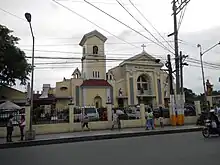
San Pedro is home for the famous Krus ng San Pedro Tunasán. Majority of the people are Roman Catholics. Other religious groups include are the Members Church of God International (MCGI), Lighthouse Apostolic Ministry of Pentecost (LAMP), Jesus Miracle Crusade International Ministry (JMCIM), United Church of Christ in the Philippines (UCCP), Jesus Is Lord Church (JIL), Jesus Christ the Lifegiver Ministries (JCLM), Christ Lord of Zion (CLOZ), and other full gospel churches under Christian Leaders Association of San Pedro (CLASP), Iglesia Ni Cristo (INC), The United Methodist Church, Presbyterian Churches, Christian Bible Baptist Church, other Baptist and Bible Fundamental churches. Islam is also practiced within the community. There are 15 Catholic parishes in the city, full gospel churches, and one mosque.
Economy

Most economic activity in San Pedro is concentrated at San Antonio, also the city's largest and most populous barangay. Barangay Nueva, the city center, is home to a central public market (palengke) as well as clothing and homeware stores, and some supermarkets. San Pedro also has a large number of factories, most notably the Alaska Milk Corporation factory in San Antonio.
Agriculture
Agricultural lands now account for only thirteen hectares of the total land area due to residential, commercial and industrial conversions. There are lands with slope ranging from 8%-15% of the total land area located in parts of barangays San Antonio and San Vicente planted with mangoes and siniguelas trees. Livestock and poultry businesses operate in the area.
Commerce and industry

There are more than 4,700 total business establishments, 40+ commercial, savings and rural banks, 110+ restaurant, cafeteria, and other refreshment parlor, and two public and five private markets and supermarkets. There are 40 banks, over 60 pawnshops, over 30 lending institutions and 11 insurance companies operating in the city. Commercial and business establishments are mostly concentrated at Pacita Complex and Rosario. A large percentage of industrial and manufacturing establishments of San Pedro is located on the adjacent barangays of San Vicente and San Antonio; E&E Industrial Complex is located in San Antonio where some of the city's factories are situated.
Malls
San Pedro has two major malls such as Robinsons Galleria South (located in Barangay Nueva, opened in 2019)[39] and SM Center San Pedro (located in Barangay United Bayanihan, opened in 2023).[40]
Tourism
Sampaguita Festival
The annual City Festival is celebrated in the second week of February. This week-long festival includes various activities ranging from cultural to sports, trade fairs, amateur singing contests, parades, historical exhibits, social and religious gatherings, tribal dances, street dances, cheering and sport exhibitions. The highlight of the festival is the coronation night of the "Hiyas ng San Pedro". The festival aims to promote tourism in San Pedro and to revitalize Sampaguita industry in the community. The celebration was formerly known as "Manok ni San Pedro Festival", which started in 1999 and was renamed to "Sampaguita Festival" in 2002. The celebration kicked off with a grand parade.
San Pedro City holds the record of laying the longest sampaguita (flower lei) line, spanning 3.6 km (2 mi), from Biñan–San Pedro boundary to San Pedro–Muntinlupa boundary on the National Highway; this was listed in the Guinness World Records in 2009.
Christmas Festival
Paskuhan Sa San Pedro is an annually celebrated festival in San Pedro City. It starts at the beginning of December and runs to the end of the month. The opening is a grand parade which is participated in by public and private schools in the city, local government and other socio-civic organizations. The main event of the opening is the lighting of the whole plaza, fireworks display, and various school performances. Every night a variety of shows are performed by the participants, which last up to midnight. On December 29 of every year the cityhood anniversary of San Pedro is celebrated.
Salvador Laurel Museum and Library
The museum preserves and celebrates the insurmountable professional and political achievements of former Vice President Salvador Laurel, located at Holiday Hills.[41]
Transportation
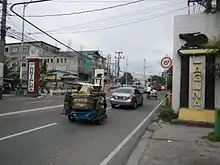
San Pedro is traversed by the South Luzon Expressway, which roughly cuts through the middle of town, and the older National Highway (Route 1), an at-grade route mostly used by public transportation.
San Pedro is at the terminus of numerous city bus routes, and the central bus terminal is at Pacita Complex. Jeepneys ply the highway, and there are also jeepneys that connects the barangays to the west. Most of the city is served by tricycles, while barangay Landayan and some subdivisions (gated communities) have pedicabs as well.
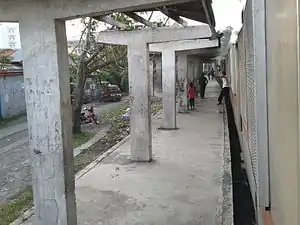
The PNR Metro Commuter Line serves the city, with two stations: San Pedro (at barangay San Vicente) and Pacita Main Gate (at Nueva).
Healthcare
Throughout the city, healthcare is primarily provided at the Barangay Health Centers in every barangay. Also, several medical missions are operated and provided by local and international organizations. The major hospitals in the city are:
- Jose L. Amante Emergency Hospital (Barangay Santo Niño)
- Gavino Alvarez Lying-In Center (Barangay Narra)
- San Pedro Doctors Hospital (Manila South Road-Landayan)
- Divine Mercy Hospital (Guevara Subd.)
- Westlake Medical Center (Manila South Road-Pacita Complex)
- Evangelista Medical Specialty Hospital (Macaria Ave.-Pacita Complex)
- Family Care Hospital (Macaria Ave.-Pacita Complex)
Housing
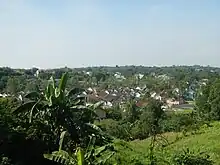
Most people in San Pedro live in over 59 subdivisions, that are either gated communities or open residential areas. The city is also a location of several government-led relocation projects. Squatters, or informal settlers, are scattered over the city.
Education

The Department of Education Region IV-A - Division of San Pedro supervises the operation of over 12 public elementary schools and 7 public high schools and provides permits to over 35 private schools, including Catholic schools. Private schools are scattered throughout the city, especially on the subdivisions. With the implementation of the K-12 program, some private schools added senior high schools, and many public high schools still have limited facilities for senior high schools.
Tertiary education and technical education are provided by several institutions scattered across the city. Saint Louis Anne Colleges has three campuses. The campus on the Old National Highway is for college students. The campus in Elvinda Village is for Pre School, Elementary High School and TESDA Courses. The Saint Louis Anne Annex campus near Harmony Mall is for students living at UB, Sampaguita, Langgam, etc. The Laguna Northwestern College has two campuses in San Pedro, one being a branch in Pacita Complex and the other one at A. Mabini Street. Polytechnic University of the Philippines has one campus in the city. San Pedro College of Business Administration in Barangay Nueva provides courses related to business administration. San Pedro City Polytechnic College, located at Barangay Narra, opened in 2017.[42]
San Pedro Relocation Center National High School is a campus for high school to senior high school students. The Pacita Complex National High School has a STEM-Program as well as the Basic Education Curriculum.
List of schools
- Adelina 1 Complex Elementary School, San Antonio
- Adelina 1 National High School, San Antonio
- Holiday Hills, Sisters of Mary Immaculate School, San Antonio
- Amazing Grace School, Inc., San Vicente
- Bagong Silang Elementary School, Bagong Silang
- Casa del Niño Montessori School, Pacita 1
- Casa del Niño Science High School, Pacita 2
- Chrysanthemum Elementary School, Chrysanthemum
- Cuyab Elementary School, Cuyab
- Cuyab Integrated National High School, Cuyab
- Cittadini School, San Antonio
- Collegio de San Pedro, Pacita 1
- Greatland school of San Pedro, San Antonio
- Doña Pilar M. Alberto Integrated High School, Landayan San Pedro Relocation Center NHS, Landayan
- Estrella Elementary School, Estrella
- Jesus the Risen Savior School, San Antonio
- Laguna Resettlement Community School, United Bayanihan
- Landayan Elementary School, Landayan
- Langgam Elementary School, Langgam
- Living Waters Christian School, Fatima
- Magsaysay Elementary School, Magsaysay
- Maranatha Christian Academy, Landayan
- Mater Ecclesiae School, Maharlika
- Pacita Complex 1 Elementary School, Pacita 1
- Pacita Complex 2 Elementary School, Pacita 2
- Pacita Complex National High School, Pacita 1 and Pacita 2
- Pacita Complex Senior High School, Pacita 1
- Rosario Complex Elementary School, Rosario
- Sampaguita Village Elementary School, Calendola
- Sampaguita Village National High School, Calendola
- San Antonio Elementary School, San Antonio
- San Isidro Elementary School, Bayan-bayanan
- San Pedro Central Elementary School, Poblacion
- San Pedro Relocation Center National High School - Main, Langgam
- San Roque Elementary School, San Roque
- San Vicente Elementary School, San Vicente
- Santo Niño Elementary School, Santo Niño
- Southville 3A Elementary School, San Antonio
- Southville 3A National High School, San Antonio
- San Lorenzo School Pre-elementary bldg, San Antonio
- San Lorenzo School, San Antonio
- Upper Villages Christian Academy, United Bayanihan
Government
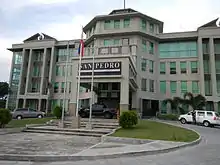
City Council
| Name | Party | ||
|---|---|---|---|
| House of Representatives | |||
| Ann Matibag | Lakas | ||
| City Mayor | |||
| Art Joseph Francis Mercado | Lakas | ||
| City Vice Mayor | |||
| Divina D. Olivarez | Lakas | ||
| City Councilors | |||
| Sheriliz Niña B. Almoro | Lakas | ||
| Michael M. Casacop | Lakas | ||
| Joie Chelsea V. Villegas | Lakas | ||
| Vincent Jude T. Solidum | Lakas | ||
| Mark S. Oliveros | Lakas | ||
| Leslie E. Lu | Nacionalista | ||
| Aldrin Gerrold C. Mercado | Lakas | ||
| Bernadeth V. Olivarez-Cuevas | KANP | ||
| Carlson S. Ambayec | PDP–Laban | ||
| Jose Enrico M. Mendoza | Lakas | ||
| Iryne V. Vierneza | PDP–Laban | ||
| Marion A. Acierto | Nacionalista | ||
| Ex Officio City Council Members | |||
| ABC President | Diwa T. Tayao (San Vicente) | ||
| SK President | Earl Gius Z. Castasus (San Vicente) | ||
List of former chief executives
Municipal mayors:
- Francisco Santiago (1725)
- Turibio Almieda (1901-1902)
- Jose Guevarra (1908-1910)
- Apolonio Morando (1910-1912)
- Jose H. Guevarra (1921-1922)
- Tiburcio Morando (1916-1921; 1922-1925)
- Victor Vergara (1925-1926)
- Jose Martinez (1928-1934)
- Ciriaco M. Limpiahoy (1934–1942)
- Antonio Partoza (1945)
- Benedictio Austria
- Gavino Y. Alvarez
- Mario M. Brigola (1960-1963)
- Jose L. Amante (1941; 1946-1947)
- Felicisimo "Fely" Almendrala Vierneza (1972–1986; 1998–2007)
- Ernesto Climaco (1988)
- Calixto Cataquiz (1986–1988, 1988–1998; 2007–June 24, 2013)
- Norvic D. Solidum (June 24–30, 2013)
- Lourdes S. Catáquiz (June 30–December 28, 2013)
City mayors:
- Lourdes S. Catáquiz (December 28, 2013 – June 30, 2022)
- Art Joseph Francis Mercado (June 30, 2022 – present)
Notable personalities
Entertainment
- Cacai Bautista, comedian
- Julia Clarete, TV host, actress
- John Lloyd Cruz, actor, model
- Jane De Leon, actress
- Ogie Diaz, comedian, columnist and TV host
- Paw Diaz, actress
- Marlann Flores, actress
- Kristine Hermosa, actress
- Michael Angelo Kyle Sayson, MLBB Pro Player, MLBB World Champion
- Jan Manual, actor
- Rocco Nacino, actor
- Jamilla Obispo, actress
- Gladys Reyes, actress
- Christopher Roxas, actor
- Nathalie Hart, actress
- Nikki Valdez, actress
- Jiggly Caliente, actress, drag queen
- Jake Zyrus, singer, songwriter
Music
- Rico Blanco, singer, former vocalist of Rivermaya
Pageants
- Stephanie Retuya, contestant and runner-up in Asia's Next Top Model (cycle 1)
- Desiree Verdadero, Miss Universe 1984 3rd runner-up
Politics
Journalism and Broadcasting
- Tony Calvento, print/broadcast journalist for The Calvento Files
Sports
- Jema Galanza, PVL MVP, UAAP Beach Volleyball champion for Adamson University Lady Falcons
- Chris Javier, basketball player
- Kyla Atienza, volleyball player
- Maoi Roca, basketball player, actor
References
- ↑ San Pedro now a component city of Laguna - Philstar.com
- ↑ http://www.comelec.gov.ph/?r=Archives/Plebiscites/PlebiscitesSanPedroLaguna
- ↑ City of San Pedro | (DILG)
- 1 2 3 4 5 "Annual Audit Report". Commission on Audit.
- ↑ "2015 Census of Population, Report No. 3 – Population, Land Area, and Population Density" (PDF). Philippine Statistics Authority. Quezon City, Philippines. August 2016. ISSN 0117-1453. Archived (PDF) from the original on May 25, 2021. Retrieved July 16, 2021.
- 1 2 Census of Population (2020). "Region IV-A (Calabarzon)". Total Population by Province, City, Municipality and Barangay. Philippine Statistics Authority. Retrieved July 8, 2021.
- ↑ Laguna (province)#Administrative divisions
- ↑ "PSA Releases the 2018 Municipal and City Level Poverty Estimates". Philippine Statistics Authority. December 15, 2021. Retrieved January 22, 2022.
- ↑ Sub-national HDI. "Area Database – Global Data Lab".
- ↑ "Philippine Standard Geographic Code (PSGC) | Philippine Statistics Authority".
- 1 2 3 4 5 6 San Pedro, Laguna Official Website - History
- 1 2 "San Pedro City". DILG.
- ↑ Nymphaea nouchali
- ↑ "San Pedro Historical Council". Facebook. Archived from the original on February 26, 2022.
- ↑ "San Pedro Historical Council". Facebook. Archived from the original on February 26, 2022.
- ↑ Act No. 939 (October 12, 1903), An Act reducing the thirty municipalities of the Province of La Laguna to nineteen, Lawyerly, retrieved June 15, 2023
- ↑ Act No. 1308 (October 29, 1906), An Act Increasing the Number of Municipalities in the Province Of La Laguna from Twenty to Twenty-one, by Separating From Biñan the Former Municipality of San Pedro Tunasan, Reconstituting the Latter as a Municipality, and Giving to Each the Territory Which It Comprised Prior to the Passage of Act Numbered Nine Hundred and Thirty-nine, Senate of the Philippines Legislative Digital Resources, retrieved June 16, 2023
- ↑ Cruz-Araneta, Gemma (October 20, 2008). "Part of History". With One's Past. Retrieved February 28, 2016.
- ↑ Act No. 2390 (February 28, 1914), An Act Changing the names of the municipalities of Santo Niño and Mawanan, Province of Cagayan; San Isidro Labrador and San Isidro de Potot, Province of Pangasinan; San Francisco de Malabon and Santa Cruz de Malabon, Province of Cavite; Nagpartian and San Miguel, Province of Ilocos Norte; Langaran, Province of Misamis; San Pedro Tunasan, Province of Laguna; Cabagan Nuevo, Province of Isabela; Nueva Caceres, Province of Ambos Camarines; San Pedro Macati, Province of Rizal; San Juan de Bocboc, Province of Batangas; San Juan, Province of Nueva Ecija; township of Barrit - Luluno, Province of Ilocos Sur, and of the Barrios of Tublijon and Gibigaan, Municipality of Sorsogon, Province of Sorsogon, Lawyerly, retrieved July 18, 2022
- ↑ "Abelardo "Captain Remo" Remoquillo". Facebook. Archived from the original on February 26, 2022.
- ↑ gov.ph
- ↑ http://www.pna.gov.ph/index.php?&sid=10++.&pfn=720424&arch=1&go=Go&search_arch&andor&mdte_arch=12&ddte_arch=30&ydte_arch=2014
- 1 2 "San Pedro City eyed as 18th member of MMDA". Manila Bulletin. December 31, 2014. Archived from the original on December 31, 2014. Retrieved September 7, 2018.
- ↑ "Press Release - Koko seeks the creation of San Pedro City as a separate congressional district". www.senate.gov.ph. Senate of the Philippines. Retrieved September 7, 2018.
- ↑ "MUNICIPALITY/CITY:City of San Pedro". Philippine Statistics Authority (National Statistical Coordination Board).
- ↑ "PLEBISCITE TO RATIFY THE CREATION OF SEVEN (7) NEW BARANGAYS SEPARATE AND DISTINCT FROM ITS MOTHER BARANGAY OF SAN VICENTE, SAN PEDRO CITY, LAGUNA". Philippines: Commission of Elections. June 11, 2015. Archived from the original on July 20, 2015.
- ↑ "San Pedro: Average Temperatures and Rainfall". Meteoblue. Retrieved May 11, 2020.
- ↑ Census of Population (2015). "Region IV-A (Calabarzon)". Total Population by Province, City, Municipality and Barangay. Philippine Statistics Authority. Retrieved June 20, 2016.
- ↑ Census of Population and Housing (2010). "Region IV-A (Calabarzon)" (PDF). Total Population by Province, City, Municipality and Barangay. National Statistics Office. Retrieved June 29, 2016.
- ↑ Censuses of Population (1903–2007). "Region IV-A (Calabarzon)". Table 1. Population Enumerated in Various Censuses by Province/Highly Urbanized City: 1903 to 2007. National Statistics Office.
{{cite encyclopedia}}: CS1 maint: numeric names: authors list (link) - ↑ "Province of Laguna". Municipality Population Data. Local Water Utilities Administration Research Division. Retrieved December 17, 2016.
- ↑ "Poverty incidence (PI):". Philippine Statistics Authority. Retrieved December 28, 2020.
- ↑ "Estimation of Local Poverty in the Philippines" (PDF). Philippine Statistics Authority. November 29, 2005.
- ↑ "2003 City and Municipal Level Poverty Estimates" (PDF). Philippine Statistics Authority. March 23, 2009.
- ↑ "City and Municipal Level Poverty Estimates; 2006 and 2009" (PDF). Philippine Statistics Authority. August 3, 2012.
- ↑ "2012 Municipal and City Level Poverty Estimates" (PDF). Philippine Statistics Authority. May 31, 2016.
- ↑ "Municipal and City Level Small Area Poverty Estimates; 2009, 2012 and 2015". Philippine Statistics Authority. July 10, 2019.
- ↑ "PSA Releases the 2018 Municipal and City Level Poverty Estimates". Philippine Statistics Authority. December 15, 2021. Retrieved January 22, 2022.
- ↑ "This new mall in Laguna has art in every corner". ABS-CBN News. Retrieved September 9, 2019.
- ↑ "SM San Pedro Opens". Manila Standard. October 14, 2023. Retrieved October 14, 2023.
- ↑ "Salvador H Laurel museum and library". Salvador H. Laurel.
- ↑ https://cityofsanpedrolaguna.gov.ph/citizens-charter-san-pedro-city-polytechnic-college/







.svg.png.webp)